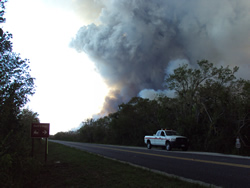
National Fire Plan Success Story
Roadside Prescribed Burn Helps Firefighters Contain Wildfire
Everglades National Park, Florida
National Fire Plan - Fuels Reduction, Firefighting
2009

Smoke column from the Hells Bay Fire taken along Main Park Road. NPS photo by Sarah Chmielewski.
On May 25, 2009, a National Park Service (NPS) reconnaissance flight discovered a wildfire in the coastal prairies of Everglades National Park. Due to shifting winds, the fire had a high potential to affect the Everglades Main Park Road and Cape Sable Seaside Sparrow habitat. The fire was spreading through continuous fuels, blow-down, and litter remnants of hurricanes Wilma and Katrina in 2005. When the fire reached predetermined trigger points, Everglades fire personnel proceeded with a preplanned burnout operation in order to secure Main Park Road and prevent the intense head fire from spotting across the road and threatening the federally listed sparrow’s habitat. Aerial ignitions and two Type 6 engines held the fire from crossing the road. The Hells Bay Fire burned 5,946 total acres.
A prescribed fire project from last December made firefighters’ work easier. The Hells Bay Fire burned into an area where the Roadside Prescribed Burn, conducted by NPS firefighters on December 29, 2008, had already reduced hazardous fuels significantly on 335 acres. According to Everglades Hells Bay Fire Incident Commander, Robert Trincado, “The recent Roadside Prescribed Burn conducted in December 2008 facilitated our burnout operation. The reduced fuel levels from the prescribed burn decreased fire personnel and visitor exposure to the wildfire as it progressed towards the road and the fire burned in the expected area with minimal smoke impacts on the road.”
Contact: Rick Anderson, Fire Management Officer, (305) 242-7853.